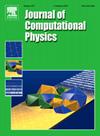Wave-appropriate multidimensional upwinding approach for compressible multiphase flows
IF 3.8
2区 物理与天体物理
Q2 COMPUTER SCIENCE, INTERDISCIPLINARY APPLICATIONS
引用次数: 0
Abstract
This paper introduces multidimensional algorithms for simulating multiphase flows, leveraging the wave structure of the Euler equations in characteristic space and the physical properties of variables in physical space. The algorithm applies different reconstruction schemes to acoustic, vorticity, and entropy waves in characteristic space to enhance accuracy and minimize numerical artifacts. In characteristic space, upwind schemes are used for acoustic waves, central schemes for vorticity and entropy waves, and Tangent of Hyper-bola for INterface Capturing (THINC) reconstruction for material interfaces and contact discontinuities (a subset of entropy waves). This approach prevents spurious vortices in periodic shear layers, accurately captures vortical structures in gas-gas and gas-liquid interactions, and improves the accuracy of shock-entropy wave interactions. In physical space, phasic densities are computed using THINC in regions of contact discontinuities and material interfaces, while tangential velocities are calculated with central schemes to improve vortical structures. An adaptive reconstruction technique is also introduced to mitigate oscillations near shocks, which arise from primitive variable reconstruction, by combining primitive and characteristic variable reconstructions with the liquid phase being identified using the stiffened gas parameter. The proposed multidimensional upwinding approach outperforms traditional schemes, demonstrating superior accuracy in capturing physical phenomena, reducing numerical artifacts, and better matching experimental results across complex test cases.
可压缩多相流的适合波动的多维上旋方法
本文介绍了利用欧拉方程在特征空间中的波动结构和物理空间中变量的物理性质来模拟多相流的多维算法。该算法对特征空间中的声波、涡度波和熵波采用不同的重构方案,以提高精度并最大限度地减少数值伪影。在特征空间中,对声波采用逆风格式,对涡度波和熵波采用中心格式,对材料界面和接触不连续面(熵波的一个子集)采用双曲线切线法进行界面捕获(THINC)重建。该方法可防止周期性剪切层中的虚假涡,准确捕获气-气和气-液相互作用中的涡结构,并提高激波-熵波相互作用的精度。在物理空间中,在接触不连续区域和材料界面区域使用THINC计算相密度,而切向速度使用中心方案计算以改进涡旋结构。本文还引入了一种自适应重构技术,通过将原始变量重构和特征变量重构与使用强化气体参数识别的液相相结合,来减轻由原始变量重构引起的冲击附近振荡。所提出的多维上绕方法优于传统方案,在捕获物理现象、减少数字伪影以及在复杂测试用例中更好地匹配实验结果方面表现出更高的准确性。
本文章由计算机程序翻译,如有差异,请以英文原文为准。
求助全文
约1分钟内获得全文
求助全文
来源期刊

Journal of Computational Physics
物理-计算机:跨学科应用
CiteScore
7.60
自引率
14.60%
发文量
763
审稿时长
5.8 months
期刊介绍:
Journal of Computational Physics thoroughly treats the computational aspects of physical problems, presenting techniques for the numerical solution of mathematical equations arising in all areas of physics. The journal seeks to emphasize methods that cross disciplinary boundaries.
The Journal of Computational Physics also publishes short notes of 4 pages or less (including figures, tables, and references but excluding title pages). Letters to the Editor commenting on articles already published in this Journal will also be considered. Neither notes nor letters should have an abstract.
 求助内容:
求助内容: 应助结果提醒方式:
应助结果提醒方式:


